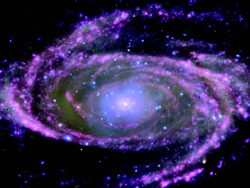Scientific Discovery Proves That We Have Much to Learn
 Recently, astronomers have reported the discovery of some of the biggest black holes found in the universe. One of these gargantuan behemoths, NGC 4889, observed from the Hubble Space Telescope, has a mass of about 21 million times more than that of our sun and is distanced at an incredible 336 million light-years (about two million trillion miles) away, according to the New York Times. The results of their work can shed some major light on black holes and their formation, no pun intended.
Recently, astronomers have reported the discovery of some of the biggest black holes found in the universe. One of these gargantuan behemoths, NGC 4889, observed from the Hubble Space Telescope, has a mass of about 21 million times more than that of our sun and is distanced at an incredible 336 million light-years (about two million trillion miles) away, according to the New York Times. The results of their work can shed some major light on black holes and their formation, no pun intended.
Scott Suter, junior biochemistry major, said, “It’s amazing how the universe can be analyzed on a grand and atomic scale, and yet we have no clue what it’s trying to explain to us. These giant black holes are awe-inspiring and bewildering. It just goes to show that we don’t have a clue as to what’s next.”
To better understand what black holes are, imagine a massive star that is about nine to 20 times the mass of the sun. When this star finally matures, the remnant core is about three times the mass of the star. If that remnant, when it stops fusing and stops having an outward pressure, has enough density, it will cause a supernova and release a sublime shockwave throughout the rest of the universe. The star will then condense into what is known as a neutron star.
Stars that are the size of the sun will collapse into white dwarfs, which are roughly the size of Earth. The pressure that prevents these from collapsing further is known as the electron degeneracy pressure, where their atoms are being squeezed to the center so much that the electrons actually create a cushion, preventing the atoms from being squeezed any further.
However, if the pressure gets large enough, the magnitude of force per unit area reaches a level so high that it actually overcomes the electron degeneracy pressure, causing the white dwarf to become a neutron star, now held by an inner neutron degeneracy pressure that prevents it from collapsing further.
What is especially unintuitive is that a neutron star actually has a higher mass than a white dwarf according to NASA. A teaspoon of this material composing a neutron star would weigh about five billion tons on Earth.
Certain stars 20 times more massive than the sun should have a remnant that is three to four times more massive than the sun. These stars, it turns out, are so large that even the neutron degeneracy pressure will not be enough to keep their mass from imploding any further such that they could attain an even greater “quark degeneracy pressure” at these insane densities.
As the star continues to collapse, it eventually reaches a point of infinite mass density where all the original mass of the star has been imploded to a single infinitely small point known as a black hole.
This point of so-called “infinite mass density” is a singularity, a region where all our math and physics equations break down and do not give defined answers. Even Albert Einstein considered black holes amongst his “weirdest” predictions in his theory of general relativity as they would exhibit infinite curvature in space-time, according to the New York Times.
Dr. Bradley Ingebrethsen, chemistry and physics professor, said, “One of the many things Einstein’s theory predicted that were too much of an abstraction, we are now finding out are true. I wonder what else he has for us.”
The reason the boundary of a black hole is hard to define is that there is some point in space where no matter how much energy an object has, it will not be able to escape the gravitational influence of the black hole.
That boundary, called the event horizon, is essentially a sphere around that singularity where anything closer or within it has to end up in the singularity.
Since not even light can escape the awesome magnitude of the gravitational force about that singularity, black holes appear black as they do not emit any type of electromagnetic radiation from themselves.
As the black hole continually devours neighboring stars which get trapped by the singularity’s gravity, their masses get squeezed more and more in increasingly smaller volumes where the particles accelerate faster and faster reaching unbelievable temperatures.
The black holes mentioned above are categorized as stellar black holes, as they form from collapsing stars. These are child’s play compared to the second class of black holes: supermassive black holes. If the word “super” isn’t big enough, these monsters are on the order of 100,000’s to billions of solar masses.
As black holes ingest everything with an angular velocity that is too slow to escape their gravitational pull, certain masses that have just the right angular velocity can actually avoid being sucked in. These will eventually orbit the black hole around this “accretion disk,” a behavior that has led physicists to the notion of black holes to be the forerunners of galaxies.
“The fact that such enormous objects have only just recently been discovered,” said Sam Broadbent, sophomore chemistry major, “truly shows how little we know about our universe. I am sure that there will be many more awe inspiring discoveries to come in time.”
Interestingly, there don’t appear to be any black holes between stellar and supermassive black holes. So the obvious question arises, if all black holes formed from collapsing stars, why don’t we see anything in between?
One explanation of this behavior states that supermassive black holes formed shortly after the big bang following the beginning of the universe.
Black holes require an intensely dense amount of mass in a very small volume so that the gravitational pull of its particles will pull them in close and closer to overcome their electron, neutron, and quark degeneracy pressures to eventually collapse into what we think is an infinitely dense single point.
At the big bang, since the universe was smaller, all the matter was in a much denser space. At that point in time, the universe was relatively uniform so there was no reason for black holes to exist as the gravitational force was consistent throughout.
Theoretical physicists suggest that shortly following the Big Bang however, slight quantum fluctuations introduced an element of non-uniformity that caused an inward force in areas of higher densities that pulled mass from areas of lower densities, forming, according to NASA, primordial black holes.
Even though the portrait this hypothesis paints of the true function of black holes is far from complete, it does provide a reason to show how the primordial universe may have catalyzed the synthesis of supermassive black holes such as NGC 4889.
Shivam Patel, a sophomore biology major, feels that “the discovery of the biggest black hole thus far marks a huge achievement in science at this time. As we learn more and more about the cosmos, we might be able to discover intelligent life on other planets.”
PHOTO COURTESY of universetoday.com



